Published:
2011
Bon Bon’s biodiversity revealed
James
Porteous
A biodiversity audit on Bon Bon Station Reserve in the arid north of South Australia has revealed a treasure trove of native plant and animal species.
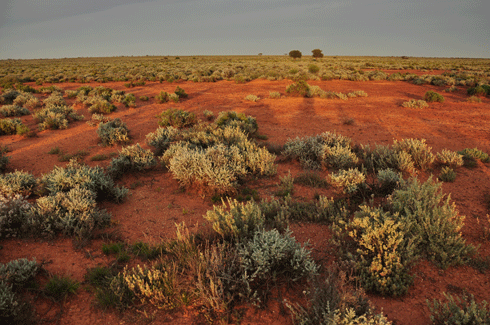
|
|
Sunset over a saltbush plain at Bon Bon Station Reserve.
Credit: Annette Ruzicka
|
Located south of Coober Pedy, the vast former pastoral property, Bon Bon Station, is now owned by Bush Heritage Australia. In October 2010, more than 20 scientists and volunteers arrived for a five-day biodiversity survey. Their expedition was part of Bush Blitz, a three-year multi-million dollar partnership between the Australian government, BHP Billiton, Earthwatch and AusPlots. The continent-scale survey – begun in March 2009 – aims to find, collect and identify the species not yet fully assessed by science that live in the large habitat areas of our national reserve system.
1
Amazingly, 75 per cent of Australia’s biodiversity is still to be described or discovered. In an era when biodiversity loss is a focus, Bush Blitz is helping scientists to track changes to habitats and biodiversity against environmental influences such as climate change and feral species.
The program has a timely focus on taxonomy – the categorisation and naming of species – as fewer people are taking a specialist interest in different groups of organisms. Without good taxonomic science, we don’t know what’s out there; what’s threatened, or not; or how to conserve it.
Groups of scientists from each state, including experts on vertebrates, invertebrates and native plants, have been conducting up to six survey expeditions each year: discovering and collecting new species, and making new distributional records – except for birds, which are already well described. The researchers report their work to the Australian Biological Resources Study (ABRS), which is coordinating Bush Blitz. The expeditions are targeting ~300 reserves that have been added to the National Reserve System within the past 15 years.
ABRS compiles main program reports for each survey and Bush Blitz data is collated yearly into a report on the state of knowledge of ~20 000 species. The first-ever report on the biodiversity in Australia’s reserve system was published in 2010, providing a baseline for the program.
Despite being a sheep grazing station for 130 years, Bon Bon Station has outstanding nature conservation values. It was purchased by Bush Heritage Australia in 2008 with federal, state and private funding.
2
Bush Heritage manages the property, with the aim of conserving and restoring its special biodiversity and natural landscapes. These include mulga, myall and black oak woodlands, chenopod shrublands, ephemeral wetlands and fringing dunes, and melaleuca drainages.
Scientists and Earthwatch volunteers worked together on the 5-day Bon Bon Bush Blitz survey. Their precious samples and data are now with state museums and herbaria for cataloguing and assessment.
Mr Andy Young, an entomologist from Kangaroo Island who specialises in moths, butterflies and beetles, was part of the team. He says the Bon Bon Station survey was a very rewarding trip, especially given that so few Australian insects have been described.
‘After a couple of good wetter seasons, the country is looking great, with signs of life recovering everywhere,’ he says. ‘I ticked off a couple of major families and have perhaps 160 new or un-named things to confirm from this trip. Most of the other scientists were coming across new things regularly too, or stuff not seen for a long time. We all pitched in and helped each other.’
Landscape ecologist Dr Jim Radford, Science and Monitoring Manager at Bush Heritage Australia, helped coordinate the survey. He says the added value of having the mix of scientists working together was a revelation and a highlight of the five-day survey.
‘The botanists from the Department of Environment and Natural Resources, Nick Neagle and Helen Vonow, turned out to be pivotal for the whole expedition,’ he says. ‘They covered most of the property, and as a result were able to provide plant species lists as background to trapping sites for the vertebrate and invertebrate ecologists.
‘There was then teamwork between the botanists and say, the bee specialists, to identify which plant species a particular bee was pollinating, so we could then begin to explore interactions and associations between species, which added depth to the data.’
Dr Radford describes the region as previously being a ‘black hole’ for biological records, but the thriving conditions produced good preliminary results for the scientists.
‘Many of the ephemeral water holes retained water, and there was lots of vegetation flowering,’ he says. ‘The botanists were pretty excited by the ephemeral species. They collected over 450 plant specimens to add to their collections, and made over 1200 plant records.’
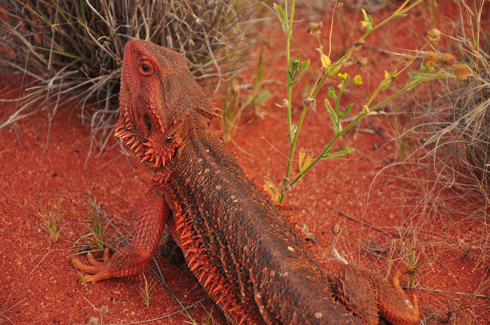
|
|
A bearded dragon can change from black to bright red before your eyes.
Credit: Annette Ruzicka
|
The mammalogists and herpetologists (reptile and amphibian specialists) also did well, with twice daily visits to different trap types in various habitats. At least six small mammals were confirmed as on site, but there are likely to be more. ‘The list of reptiles has been increased to 47, with a possible significant geographical morph [a species variation] of the broad-banded sand-swimmer [lizard].’
The entomologists collected day and night in a range of habitats, including wide salt flat areas and single, small ponds.
About the Australian National Insect Collection
|
|
The Australian National Insect Collection (ANIC) is the pre-eminent collection of Australian insects, maintained by CSIRO for researchers, industry and government agencies. |
ANIC was established in 1928, and is now the world’s largest collection of Australian insects and related groups such as mites, spiders, earthworms, nematodes and centipedes. |
More than 12 million specimens are housed in the Collection, which is based at CSIRO Entomology in Canberra, in the Australian Capital Territory. The collection grows by more than 100 000 specimens each year. |
ANIC comprises specimens collected by CSIRO staff, as well as donations and bequests from individuals and other institutions. It is an important research resource used by CSIRO researchers, university staff and students, and scientists from Australian and international research organisations. |
ANIC also produces relevant papers and books in conjunction with CSIRO Publishing and other publishers. |
|
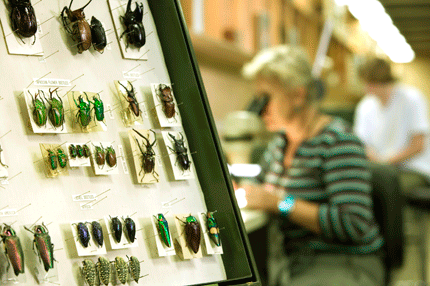 The ANIC, which holds the largest collection of Australian insects, is a central resource for taxonomists.
The ANIC, which holds the largest collection of Australian insects, is a central resource for taxonomists.
Credit: CSIRO
|
|
Mr Young kept a diary for Ecos about the trip (see below). He describes techniques he used to collect his target species and reveals the stamina and dedication needed to stay up late catching them, and then keep awake the next day to deal with the ‘pinning’ and DNA sampling of hundreds of specimens.
‘It’s hard, menial work in the field,’ says Mr Young. ‘And then there’s the time-consuming cross checking and verification of my specimens, once I get back, with the [South Australian] Museum and the Australian National Insect Collection at CSIRO in Canberra – one of the best in the world.
‘It is hard to emphasise enough the value of having such a centralised and well managed collection in Australia. Their dedicated maintenance of this resource and CSIRO’s publication of excellent insect monographs and field guides are absolutely essential to us taxonomists.’
Dr Radford says Bush Heritage will wait for summary reporting from ABRS, compiled from scientists’ accounts, and will then integrate the information into their current management plans for the property.
‘We’ll have a better idea of what’s there, and therefore, how to manage it,’ says Dr Radford. ‘With plants, for example, our vegetation mapping will now be supplemented with the species lists, and we’ll be better able to plan our fire management and weed control.
‘Bush Blitz focuses on inventory and cataloguing and so will be limited for some sorts of ecological knowledge. But even with the relatively small trapping effort, the Bush Blitz revealed helpful information on animal distributions.
‘We found that the stony plains in the north of Bon Bon that support chenopod shrublands, and particularly the low-lying clay pan depressions surrounded by low shrubs, were very diverse for vertebrates. It was amazing how many animals we could trap in such a small area, which is testament to the productivity of the habitats. The Mulga woodlands surprised us; they seemed to have relatively few species, and reptile fauna were especially low. We don’t yet know why, and it may just be seasonal or an artefact of low survey effort.
‘We can use this information to prioritise our feral predator and erosion control, now that the relative productivity of these different habitats is realised.’
‘The new information for management is probably the top highlight of the expedition from our perspective.’
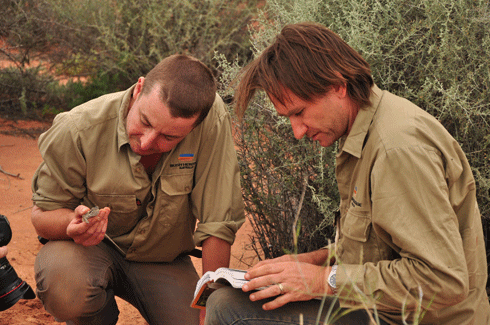
|
|
Reserve Manager Glen Norris (left) and Dr Jim Radford identify a gecko.
Credit: Annette Ruzicka
|
Mr Michael Preece, Director of the ABRS, says there is a close relationship between Bush Blitz and the National Reserve System, which is Australia’s premier investment in biodiversity conservation. This is because each Bush Blitz expedition provides a critical ‘snapshot’ of the biodiversity contained within that reserve.
Mr Preece says the expeditions’ results compiled by ABRS and provided to the reserve managers, contribute directly to the scientific knowledge underpinning adaptive management of the reserves. The accumulated Bush Blitz data will ultimately be uploaded into the Australian Government’s Australian National Heritage Assessment Tool (ANHAT). This database is an important source of information about the natural heritage significance of areas, and their priority for inclusion in the national reserve system.
‘In addition, Bush Blitz data lodged with state museum and herbaria as well as national taxonomic databases, incrementally adds to meeting our wider international obligations around biodiversity conservation,’ says Mr Preece.
‘Further careful taxonomic and genetic work on samples collected from the expeditions will clarify speciation boundaries and other taxonomic riddles, but more questions will also be thrown up. The important thing is that we are getting greater clarity on the distribution of important species.’
Read the diary of Bush Blitz entomologist, Andy Young
|
|
‘Moth man’ entomologist Andy Young’s diary provides a fun insight into his adventures and work as an insect taxonomist in the field, hunting for undiscovered species as part of Bush Blitz. His five daily entries are published below. |
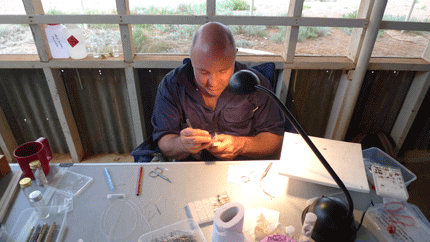 Andy in his makeshift laboratory at Bon Bon station, pinning out insect specimens.
Andy in his makeshift laboratory at Bon Bon station, pinning out insect specimens.
Credit: Kate Gillespie
|
Join Andy Young, field scientist and moth expert, as he studies and searches for insects in the arid lands of South Australia, on a Bush Blitz expedition to Bush Heritage Australia’s Bon Bon Station Reserve. |
Day 1, Sunday 24th October
|
As we headed east off the Stuart Highway and turned onto the dirt road out to Bon Bon homestead, blue bush-covered gibber plains on either side of the road dominated the landscape, broken by acacias growing in the drainage lines. |
Arriving, I was immediately distracted by bright blue Amaryllis Azure butterflies flying around. Their caterpillars hide during the day under bark, and then emerge at night to feed on mistletoe, guarded by ants that ‘milk’ the caterpillars’ nectar glands in return. |
After putting up my tent, we had to unload and sort all the gear from the trailers, and find homes for it. Over twenty people are here at the height of this Bush Blitz program, so it’s very important to respect everybody’s collecting and personal materials. |
The rest of the afternoon and early evening was taken up with introductions, briefings on the rules of the station, safety and basic housekeeping. But I was eager to run my mercury vapour light trap, as a cloud ceiling was forming and the wind was non-existent – perfect weather for attracting insects to lights! After some minor dramas setting up, I turned on the light at around 8.30 p.m. After another briefing meeting that saw me straining at the bit to get out and check what was coming into my light sheet, finally, I was off! |
The 250-W mercury vapour lamp is suspended in front of a hanging sheet. These lamps have a UV component in their emitted spectrum that most night-flying insects find very attractive. They settle on the sheet, where they can be selectively collected. |
The light sheet wasn’t as active as I have seen in the past, but over the night several thousand insects, mainly moths, came to it. I was certainly busy collecting my various groups, which are mainly tiny moths. I was also informing volunteers from Earthwatch about the creatures we were seeing. Over the evening I collected around 250 moths and other insects, and was looking forward to bed at my knock-off time of around 3.30 a.m. |
Day 2, Monday 25th October
|
I woke with a headache and wishing that I could just lie in for a while. Too many days with too little sleep had taken their toll, with the stress of trying to break camp previously at Witchelina Station as potentially flooding rains came in. The sound of light rain on the tent’s roof didn’t help either, but there were things to do, so I staggered out of bed like a bear with a sore head. |
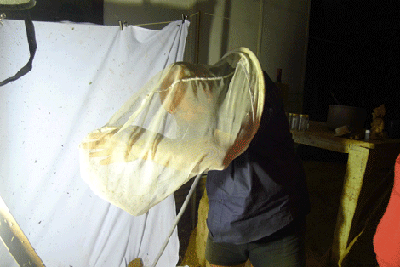 Andy inspects a catch during the evening.
Andy inspects a catch during the evening.
Credit: Kate Gillespie
|
As the day wore on, I realised that any fine motor skill activities were definitely out. I didn’t have enough patience and presence of mind to do the pinning of insects I had previously collected. This is one of the considerations when bulk handling a delicate, easily damaged specimen base. |
I am capturing all the specimens live, and not killing them straight away, as would normally be the practice. This means that I can kill them at the time I want to pin them, which stops them becoming dry and brittle, but also allows worthwhile DNA samples to be collected from the fresh specimens as a side benefit. It allows me a period of grace in dealing with the specimens that I wouldn’t otherwise have, but the other consideration is that the longer you leave the pinning, the greater the amount of material you have to process at the one time! In the first two weeks of the Bush Blitz at Witchelina Station, I had a dedicated offsider, Rowan, to help me with pinning and DNA sampling – now it’s just me! |
The work of DNA sampling is menial and time consuming. It is essential that every part of the process can be documented to the specimen the sample was obtained from, to preserve continuity. This is time I now do not have with the workload I’m undertaking. |
Two of the other Bush Blitz entomologists here, Sarah and Rebecca, based at Adelaide University, asked if we could run a light trap in a nearby soak swale we had seen on the way in to Bon Bon. The girls were collecting Hymenoptera, the order encompassing wasps, bees and ants. At around 8.00 p.m. we headed off to the spot, about six kilometres back down the track. The first insects to show were mosquitoes! Once the mercury vapour light was up and running, it took a little while for the insects to start appearing; however, we were all soon catching various types of interest, many of which hadn’t appeared on the first night. This is one of the interesting things about a light trap: in a given locality, over several consecutive days, you may only get a standard range of insects appearing. Quite often, however, you get different suites of insects every night; some common ones that are there the whole time, but others that appear, sometimes in quite large numbers, on only one night. |
After an hour, Gary, who also hails from Adelaide University, and Remko, from the South Australian Museum, also came down. Gary was collecting various bugs at the light, some of which are very small. While Australians have adopted the American slang term ‘bug’ to include all insects, it specifically refers to the order Hemiptera: all of which have modified tubular mouthparts, with which they suck animal or plant juice as a food source. |
I had filled my own jars by around 11.15 p.m. and we headed back to camp. I worked until around 1.00 a.m. pre-pinning out some of the catch from the night before, then hit the hay at ~1.30 a.m. |
Day 3, Tuesday 26th October
|
When I rose at 7.30 a.m., I knew that a huge, tedious day awaited me. I had tea, and then pinned over one hundred and eighty specimens, which took until around 2.30 a.m. the following morning. I only had half an hour off for dinner, around the same amount of time as I had actually spent at the light sheet I had going. |
While it is good to see the diurnal (both day and night time) fauna of these areas – and I have certainly contributed to other scientists’ collection bases when I have managed to get into the field during the daytime – most interesting species I am likely to encounter come to the mercury light at night. This allows me to devote the evening to collection and the days to curation. |
That said, during a daytime toilet break today, I observed what appeared to be a Hypertrophid moth flying around mistletoe on a mulga bush. This is the second observation of a day-flying Hypertrophid I’ve made during the trip, and confirms an observation made by a worker called Meyrick in 1880. |
Among today’s pinnings are several specimens that may well be new species, including one that looks very different from anything I’ve seen before. I’ll now have to go back and check Australia’s institutional collections before I can say definitively that it hasn’t been caught and described before. One of the disadvantages of working on an insect group with possibly 30 000 species in Australia is that it’s hard to recognise everything at a glance. |
Day 4, Wednesday 27th October
|
I pinned out more of the collection base from the night before, did some DNA sampling of Geometrids, and then this evening ran the light in the same spot again, close by – where we were pleased by the material collected on the first night. |
One of the issues in running a light in the same spot over several days is that the predators get to know where it is. Tonight, we have had swarms of tiny Iridomyrmex ants and Caribid beetles around the light sheet, grabbing and devouring prey. |
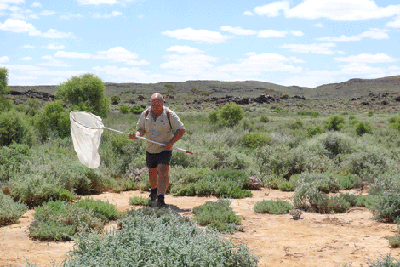 Andy Young uses his sweep net over saltbush on Bon Bon station to catch airborne insects.
Andy Young uses his sweep net over saltbush on Bon Bon station to catch airborne insects.
Credit: Kate Gillespie
|
The other story of the day has been the arrival of a team of journalists to cover the Bush Blitz. As a consequence, the work of the day was altered and several people were frustrated, as some glitches in the schedule meant they were waiting around when they could have been working. We all know the value of positive publicity, both for the organisations involved and for conservation more generally: so, in the end, we concede it’s a necessary thing. I ended up being photographed at the light sheet and doing an interview at around 12.30 a.m., then got back to the pinning work. |
Day 5, Thursday 28th October
|
Yet another day of pinning: a point of interest was when Cory, a photographer, brought in an image of some Buprestid beetles on eucalypt blossom from the far side of the property. Buprestids are also known as ‘jewel beetles’ and are typically brightly coloured, and sometimes iridescent. I would have loved to have got some samples of the beetles, as there are few records of them from South Australia’s arid areas – they may have been of interest to others. |
During the evening, the wind sprang up. Glen Norris, the reserve manager for Bush Heritage Australia, let me set up my light in an open shed, sheltered from the wind. This allowed me to collect in the evening, until the wind changed direction and started blowing into the shed. It was a slow night, however, but of the insects that did come in, several were different from what I had seen during the rest of the trip. |
Cory photographed us collecting at the light. Then, at around 12.30 a.m., he set his camera up next to my work bench and photographed me working there, fascinated by the whole process. |
I finished up at around 1.30 a.m. again. With rain threatening, I headed off to the abandoned concrete shed where I had moved my tent to stop it getting wet. A medium-sized reptile of some description was under my tent floor, but I couldn’t have cared if it was a mulga snake; nothing was going to stop me sleeping! I just pushed it away with a book and when I couldn’t feel the squirming bump anymore, went to sleep. |
Final day, Friday 29th October
|
Having spent a claustrophobic night in the shed, I woke to the final day of this short but intense trip. Inside the shelter was a piece of corrugated iron, which looked interesting. If there was a snake in the shelter, this was the most likely place for it to be. I gingerly flipped it up – only to see a gecko staring at me. I caught the little reptile and showed it to the team’s herpetologist, Steve. He identified it as a Bynoe’s gecko and said that it could be released; they had already caught a mob of them. |
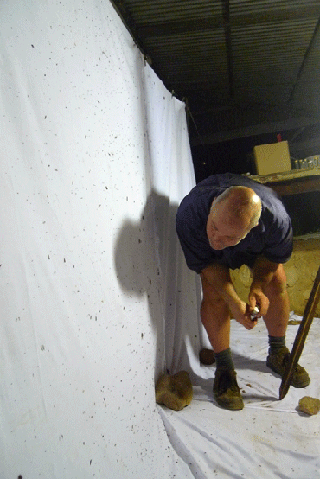 Andy inspects a catch during the evening.
Andy inspects a catch during the evening.
Credit: Kate Gillespie
|
Later, I went back to get some things from my tent. While there, I decided to flip the iron again. This time I saw a sinuous shape darting for the wall in the half-light of the shelter. I chased it and caught a smooth, banded lizard ~20 cm long, with large, gecko-like eyes. I put it in a sock I had for Steve. |
‘What’s that shiny lizard with bands like a blue-tongue, but a longer tail?’ I asked, not wanting to be told I had just caught the other most common lizard found on the trip. |
‘That would be a Centralian blue-tongue,’ said Steve. |
‘No, this one’s got a longer tail and googly eyes,’ I replied. |
Steve, somewhat exasperated by now, said ‘I don’t know then, did you catch it?’ |
I then drew the somewhat reluctant lizard from my sock, and Steve’s irritation turned to surprise. I had found the second broad-banded sand-swimmer for the trip. What made this specimen more interesting was that it was intermediate between a western form and an eastern form. This shows that the two populations are likely to interbreed in the Bon Bon area, and that their status as separate biological entities is open to doubt. |
Later, I needed to get something else from my tent and asked Steve if he wanted me to see if I could find any other reptiles in the sand of the shelter. |
‘Another sand-swimmer would be great,’ he replied, so I started off towards the shelter, butterfly net in hand. After a little poking around in the shelter, a head stuck out of the floor and I bagged a second sand-swimmer specimen. At a post-dinner debrief, Steve mentioned that he’d never seen the butterfly net technique used to catch reptiles before. |
The rest of the day was like all the days during the Bon Bon trip: long and tedious, filled with pinning and de-pinning material. |
After dinner, it was too windy to light-trap a final time, so I busied myself with starting to break down and pack the equipment. I also had to store some pinning boards of drying specimens safely for the trip back. As any one of the specimens I’d collected during the trip could end up being a ‘type’ – the important specimens on which a new species description is based – it was important to make sure all the material travelled safely. |
We had a final meeting as a group, at which the various workers gave a brief summary of what they had achieved. I couldn’t say much at that stage; it will be a quite sustained piece of work in itself to get the identifications necessary to quantify the trip’s success in terms of the new species that may have been found. |
|
More information
1
The national reserve system, which covers more than 11 per cent of the continent, is made up of more than 9000 properties: national parks and reserves managed by all levels of government, Indigenous lands and protected areas run by non-profit conservation organisations, and ecosystems formally managed for conservation by farmers as part of their working properties.
2
Two thirds of total purchase and establishment costs came from the National Reserve System (NRS) component of the federal Caring for Our Country program. The Government of South Australia also assisted. Private funding came from the Besen Family Foundation.












